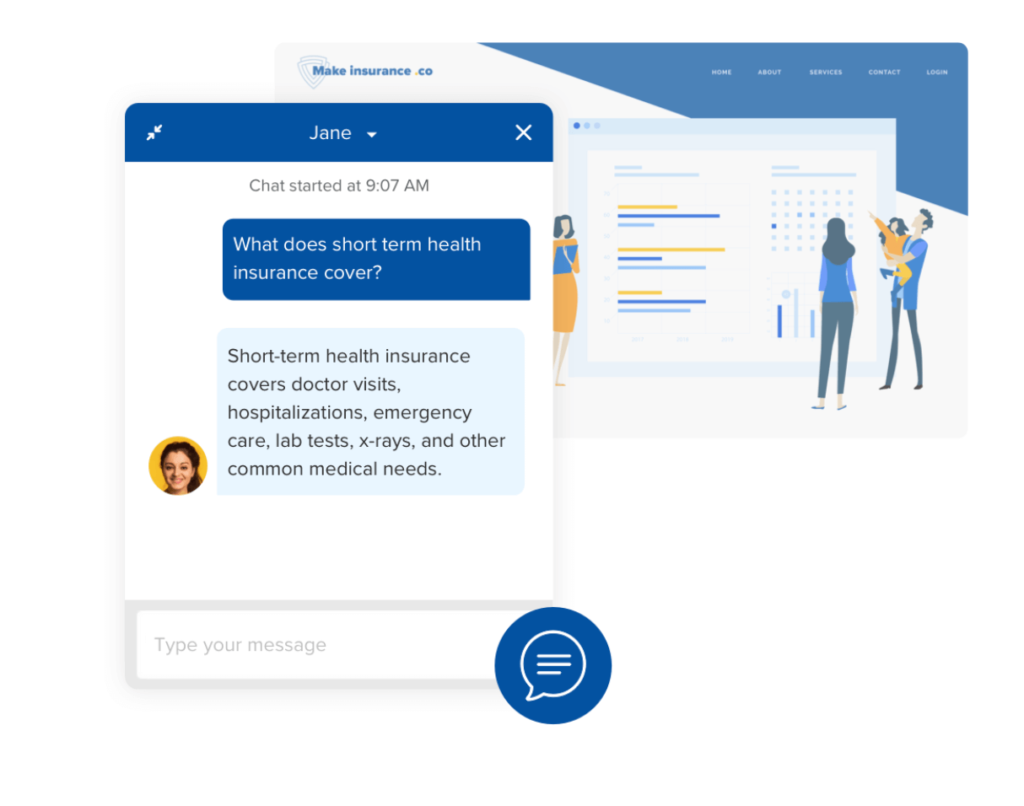Updated Sept 2020
These days, if you want to grow your business, it seems like you have to be everywhere at once. Sending emails, responding to customer inquiries, updating your website… It can be a lot to manage.
But if growth is a priority for your small business, you can’t ignore the importance of these opportunities to connect and communicate with your customers.
This kind of relationship building will continue to pay off over time, creating customers that not only make a single purchase but come back again and even tell their friends.
Especially for small businesses, communication is a crucial marketing strategy, but it can be a lot to handle on your own. Whether you choose to continue doing it yourself or hire someone to do it for you, you’ll absolutely need to invest in marketing technology, otherwise known as a marketing stack.
Marketing tech focused on your company’s communication goals can help you grow exponentially, without having to hire a huge team. That’s the magic sauce: turbo boosting revenue while keeping costs down.
Just know that “invest” doesn’t necessarily translate to “spend a boatload of money.” And in fact, there are a ton of free, nearly free, and pay-as-you-grow tools out there that—when pieced together with a little forethought—do a pretty bang-up job of streamlining your marketing communications.
In this piece, you’ll learn everything you need to know about implementing a marketing communication stack, including:
- What are marketing communication tools?
- A quick 2-step guide to choosing the right marketing communication tools for your business
- Internal vs. external marketing communication software
- 8 tools for your budget-friendly marketing communication stack
🔍 Are you thinking about purchasing a new communication tool and unsure how to get started? Here’s a checklist to help you pick the right one for your business.
What are marketing communication tools?
Marketing communication tools are software tools that enhance your ability to offer a consistent and positive marketing experience to your potential customers through communication.
Communicating is really the lifeblood of modern marketing—from broadcasts like your website and email list, to one-on-one communications through social media or the chat box on your site.
Why focus on communication? Because communication tools are critical to building a relationship with customers. And customers who have a relationship and feel a connection to your business are more likely to make a purchase.
It’s not just about the money, though—marketing communication tools empower the kind of connection that benefits your customers, too. By focusing on communication, you’ll be able to provide top-notch service, like helpful resources and quick support, to your customers and prospects.
In return, you’ll glean the kind of insights you can only get from really knowing your people. From product feedback to social media sharing and even referrals, a communications-focused marketing plan will provide numerous benefits for your growing business.
If all of that sounds overwhelming, don’t worry—that’s where the right software tools come in.
While a marketing plan focused on really connecting with customers can be time-intensive, there are a number of tools that will serve to streamline and simplify your strategy.
The right integrated marketing tools can help you get more done in less time. Through automation, smart scheduling, and streamlined information management, marketing communication tools will save you and your growing marketing department hours of wasted time.
But before we dive into the tools themselves, we want to make one important distinction: internal vs. external marketing communication software.
How to choose the right marketing communication tools for your business
Here’a a quick 2-step guide to shopping for the right communication software for your marketing team.
1. Make a list of all your marketing-communications-related tasks
Everything you’re already doing with respect to marketing can probably be automated with the right combination of tools, so make a complete list of tasks you’re already doing, like:
- “Give our marketing team members an easy way to communicate with each other including video, screen sharing, and messaging.” (Seems a like a no-brainer, but this is the level of granularity you need whenever you’re building out a stack of tools to make sure you don’t miss any key use cases.)
- “Build out a monthly newsletter calendar to send regular emails to subscribers.”
- “Add leads to master spreadsheet.”
Then, make a list of other marketing communications tasks you might anticipate doing as you become bigger and have more resources, like:
- “Post to Instagram daily.”
- “Create email nurture sequence to convert leads to customers.”
Think of this list as your wish list, which will come in handy when you’re comparing marketing communication tools later. Ideally, you want to choose tools that’ll make these tasks easier to do on a recurring basis, or even eliminate the need to do them altogether after the initial setup.
2. Narrow down your list of tools
Remember, you’re not looking for the “best marketing communication tool”—you’re looking for the best marketing communication tool for your business. Make sure you look beyond just price, features, and benefits and ask yourself the following questions:
- Do the tools I’m looking at “speak” to each other? Check out the integrations pages, and if you don’t find an integration between two tools you want to use—like a landing page building tool and a marketing data analytics tool.
- Are we likely to outgrow the tool? Tempting as it may be to default to the free tool, if it won’t scale as your business grows, you’ll just have to spend more time and money later on to transition your team and company to new software. You might still find that a free tool is worth it for now; just be sure to consider the long view and weigh the costs.
- Is it plug-and-play, drag-and-drop, easy-peasy setup? In other words, does it seem like something you can implement, or will you need to hire a developer? Either is fine, just as long as you’re prepared for the time or monetary investment involved.
- What’s the support like? This is key if you’re implementing and operating your marketing stack yourself. Some tools offer round the clock phone, email, and chat support, while others only offer support to their highest-paying customers.
Internal vs. external marketing communication software
Believe it or not, marketing communication software can be both internal, enabling open communication inside of your organization, and external, connecting you with your customers and potential customers.
At first blush, marketing communication software might seem like an exclusively customer-facing thing, but internal communications are just as important. The right behind-the-scenes technology sets the stage for creating connections and delivering a great marketing experience for customers.
Consider software like a CRM (customer relationship management) platform. Sure, it’s an internal platform since your customers will never see it, but it’s also crucial to delivering a great marketing and sales experience.
On the other side of things are platforms that connect your internal team with your customers: external marketing communication software. These are platforms like your social media management platform or the software you use to communicate with customers.
Even external marketing communication software can be further broken down into broadcasting (speaking to a lot of potential customers at once) and individual (speaking directly with a potential customer, one-on-one) communications.
Both are important for a modern marketing strategy. While some customers may only interact with your broadcast marketing before converting, giving the option of connecting one-on-one with someone from your company is a great way to endear your potential customers to your brand.
Of course, some platforms, like social media or your company blog, allow for both broadcasting and the potential of one-on-one communications through comments. It’s important to be prepared so these connections from engaged leads don’t go without replies.
8 tools for your budget-friendly marketing communication stack
Now that you know the different kinds of marketing communication softwares, it’s time to build your communication marketing stack.
Of course, different companies will require different softwares. Be sure to take this suggested list and tailor it to your specific business needs, building your own one-of-a-kind marketing communication stack.
1. Internal team messaging: RingCentral
When it comes to internal communications, there’s no more important tool than your internal team messaging platform. After all, it’s where you share project updates, ask quick questions—and maybe even send hilarious memes.
The right chat app isn’t just good for your team getting information quickly and getting back to work, though. It’s also great for customers.
Great internal communications trickle through the company, and you’d better believe that they directly affect customers as well:
- When a customer calls in with an issue, your chat app allows support staff to quickly communicate about the best way to help, without putting them on hold.
- When marketing releases a new blog post that customers might have follow-up questions about, they can quickly let everyone know at once in a group chat.
- And, if you use RingCentral, you can even invite clients or customers for free to the messaging app.
RingCentral is the best tool for internal communications because it allows your entire team to stay connected in a variety of ways that work for them. Messaging, video, phone—even screen sharing, task management, and file sharing:
Of course, you can chat with individuals and groups, but RingCentral also lets you easily jump on a video conferencing call and share your screen—all within one app. Plus, you can send any files necessary so you can always be sure everyone has what they need…

And even assign follow-up tasks:
And that’s not all—as you’ll see, RingCentral is a power player when it comes to marketing communication.
The best way to save money on marketing technology? Find tools that multitask, eliminating the need to grow an expensive, unmanageable marketing stack.
That’s what makes RingCentral a budget-friendly choice, starting at $19.99 per user, with the ability to add more users and features as your business grows. (Keep reading to see a few other tools RingCentral can replace.)
🤯 On top of all this, RingCentral could save you up to $400 an hour in IT costs.
Explore the RingCentral Advantage for small businesses:
💰 You can also use this calculator to see roughly how much your business could save by using RingCentral to support your team’s communication with each other—and clients.
2. Customer relationship management (CRM) platform: Copper
Business-to-business (B2B) sales often require more relationship management and nurturing than your standard business-to-customer (B2C) sale. A CRM can help you manage and track your leads, prompt you to follow up with them, and give you insight into how best to communicate with them.
You can even take notes in your CRM to remind you how to personalize your next email or phone call, truly building a relationship with prospects.
If you’re already using Google Workspace, Copper might be your best bet for a CRM since it lives directly within Gmail:
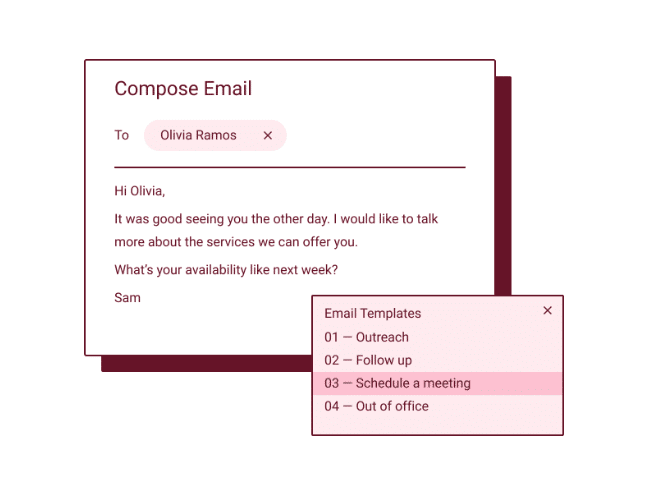
Save valuable time with personalized email templates that you can save in Copper and access right from within Gmail. That’s streamlined, personalized communication that will save you tons of time while still making customers feel connected to your brand.
3. Content management system (CMS): WordPress
Your CMS is where your website, blog, and occasionally other web properties (like landing pages) live.
As far as communication tools, this is clearly a broadcasting opportunity, but your website is also the first invitation for your customer to join you in a conversation and can turn into one-on-one opportunities as well:
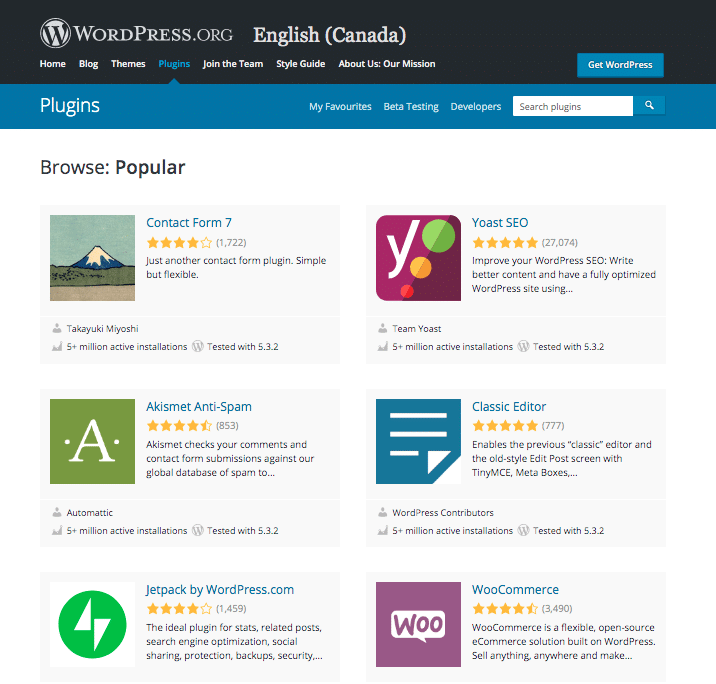
There are a few notable CMS options on the market, but an estimated 455 million websites are using WordPress right now, so you’d be in good company adopting it as your CMS.
On top of being the tried-and-true option, WordPress has the benefit of being an open-source marketing tool—meaning anyone can contribute to its impressive library of plugins that allow you to do everything from adding contact forms to supporting e-commerce.
Just a tiny drop in the bucket of 55,786 WordPress- and contributor-built plugins.
Oh, and did we mention it’s free? All you need is a domain name and web hosting, and you can hit the ground running. Just be careful you’re signing up for WordPress.org and not WordPress.com (which does cost money and can’t support plugins—think of it as the “lite” version of WordPress.org).
Streamline your tools where you can! If you can find versatile tools that do different things well, it can help you save on costs (and additional onboarding time for your team).
4. Social media conversations: RingCentral
Similar to your blog or website, social media is not just a domain for broadcasting. In fact, engagement on social media is a crucial part of the equation, signaling to the platforms that your content is valuable and making it more likely that others will see it.
Encourage social media engagement by always responding when someone comments on or replies to something you post.
But don’t worry about sitting with Twitter, Facebook, Instagram, and LinkedIn open all day waiting for mentions. Just use a software that can pull those comments into a queue, making it easy to respond quickly and consistently.
Once again, that’s functionality you can get with RingCentral. It’s a communication powerhouse, helping you stay on top of all kinds of marketing communication to keep your customers engaged:
Using RingCentral, you can manage all of your responses in one place, whether customers reach out on Facebook, email, or chat. Its artificial intelligence can even analyze and route incoming social media messages, so you can send support issues and sales questions to the right place—instantly.
You can even use chatbots to respond to simple requests and pass off more in-depth replies to human agents.
🕹️ Get a hands-on look at how RingCentral works by booking a demo:
5. Social media broadcasting: Later
Not everyone’s business benefits from an active social media presence, but if it works in your industry (think apparel companies, restaurants, and handcrafted goods), it’s an awesome way to humanize your brand and communicate directly with your target market.
Unfortunately, the key to getting social media right is consistency. Which is, to say the least, tedious. That’s why a social media scheduling tool will change your life.
Later allows you to plan, schedule, and analyze posts across Instagram, Facebook, Pinterest, and Twitter—all from a single platform.
In addition to their easy-to-use visual calendar—which makes planning a breeze—Later offers a resource library bursting with tutorials, courses, eBooks, and in-depth guides to guide your social strategy:
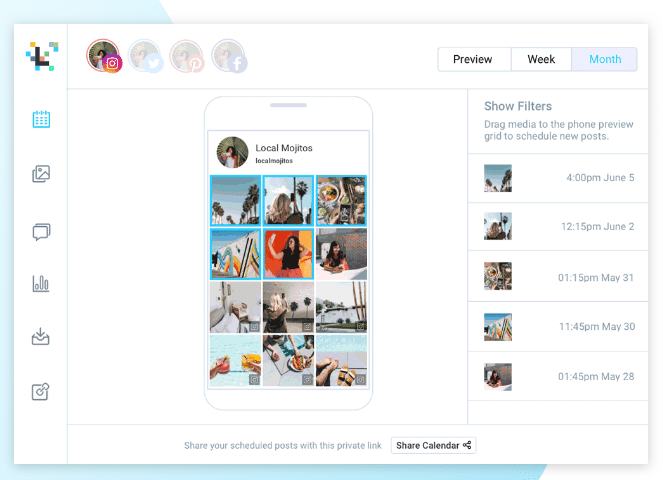
6. Website live chat: RingCentral
Ready to turn that website broadcast into a one-on-one communication? Installing live chat on your website is a great way to do that.
Live chat is a convenient way to offer your website visitors some support, answer questions as they come up, and just give customers the opportunity to connect with your brand in a deeper way.
RingCentral offers live chat that allows you to turn your website from a one-sided conversation into a true point of connection:
Optimize your live chat to close deals by identifying pages and places in the sales process where leads are likely to drop out, and put a chat box on that page.
You can even identify triggers for a chat window to appear, like time spent on a page, number of website visits, or viewing certain product pages.
Using RingCentral, chatbots can collect information to route conversations to the right agent or even resolve simple questions entirely. That’s the kind of efficiency that leads to great conversions and happy customers.
7. Email and marketing automation: Mailchimp
Email is one of the—if not the—most important marketing communication channels at your disposal, for many reasons:
- First, it’s cheap (you own your email list, and it costs nothing to reach out to them).
- Second, it actually works. A 2015 report found that email has an average ROI of $38 for each $1 spent.1
- Third, it’s a preferred channel for your customers and prospects. According to a 2016 Adestra report, 73 percent of millennials actually prefer to hear from businesses via email.2
Mailchimp has branded itself as the go-to email builder for small business owners. It features an intuitive drag-and-drop builder, beautifully designed templates, and 24/7 email and chat support for all paid plans.
Here are just a few of many automations you can set up in the Mailchimp platform:
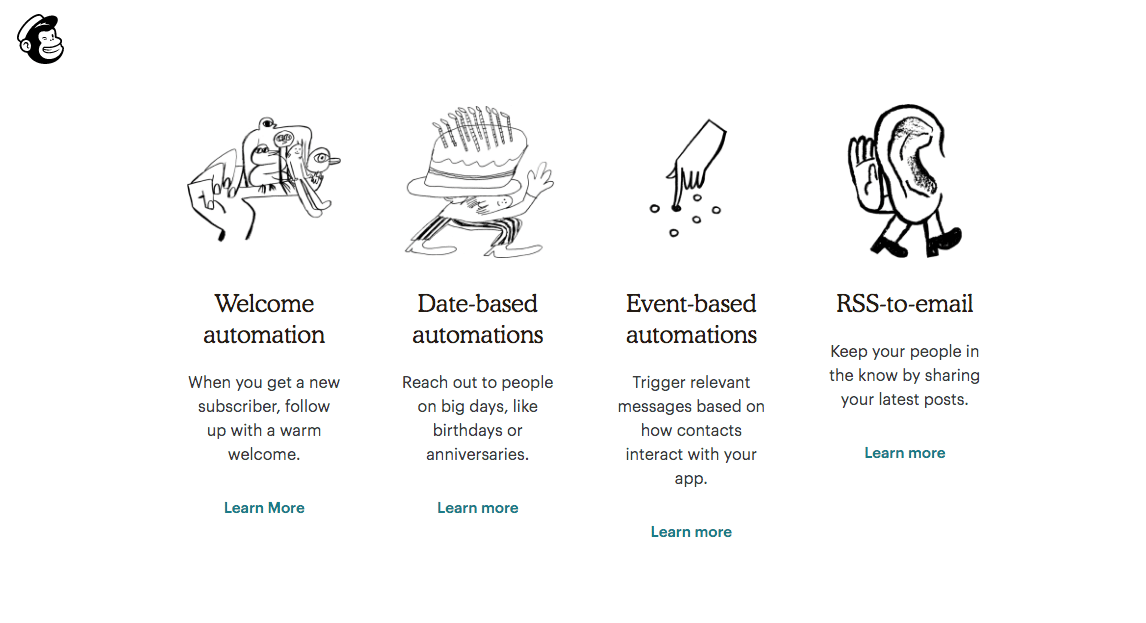
Task automations are important because they allow you to stay connected with your audience without the busy-work.
And for ambitious business owners with plans to scale, Mailchimp can help there too. What started out as just an email platform has evolved into an all-in-one marketing automation platform (featuring a website, landing page, and ad builder; customer relationship management; and more) meaning you can track the performance of full-scale marketing campaigns.
A few bonus tips on automating your marketing communications
Here are some examples of automations that can be achieved with marketing technology—remember, this is all done automatically for you, without you having to go in and manually add this information:
- Marketing automation can trigger a cart abandonment email for folks who make it to the checkout page but don’t complete the transaction
- Email software can help you create email templates and personalize welcome emails with key details such as customer name and nearest retail location—here’s an example of a typical (automated) cart abandonment email, which prompts shoppers to complete their purchase:

- Facebook’s ad platform can optimize your Facebook audiences and even ads based on how well the headlines do
- Social media scheduling can post pre-loaded content on Instagram during peak engagement times
8. Paid advertising: Google
Paid advertising is a communication tool that can help your customers find you and quickly understand your business, or remind them about your company after they’ve already visited your site.
It’s been shown that customers need to interact with your brand seven times before making a purchase, so think of paid advertising as an easy way to remind customers that you exist.3
Plus, paid advertising is a lot more approachable than you may initially think. In fact, Google Ads is an affordable and totally scalable way to get people to see your offers.
If you’re new to Google Ads, it’s a pay-per-click (PPC) advertising platform—meaning you only pay if visitors click on your ad.
It costs nothing to get started with Google Ads, although obviously you need to spend money to make money. According to calculations from Google’s Chief Economist, Hal Varian, most businesses see an average of $2 for every $1 spent on Google Ads.4
Support will be limited, but Google has an extensive help center, including an in-depth guide that details all the basics from setup to best practices to optimizing your campaigns. You can also track your results with an ad tracking tool like Voluum later on.
Understanding how your web properties are performing (or not performing) is the first step in improving your visitors’ on-site experience. Google Analytics will not only provide you with these insights, it’ll also help you gather the evidence and data you need to make improvements that translate to real results (including revenue).
Which marketing communication software tools are you using?
Communication isn’t just a company buzzword, it’s integral to everything your organization does. And where marketing is concerned, communication may be the key to your success.
With a small team, the right software tools are key to unifying your various marketing communication platforms and creating simple, manageable systems to keep them all moving forward.
Most importantly, these software tools make it easier to sincerely connect with and communicate with your customers and prospects. That’s the kind of connection that makes for happy customers, business development opportunities, and, of course, sales.
You don’t have to be everywhere at once—but it doesn’t hurt to give that impression.
1 emailmonday.com/dma-national-client-email-report-2015
2 content.adestra.com/consumer-adoption-usage-study-1
3 netimperative.com/2017/01/30/path-purchase-7-interactions-purchase-produces-optimum-online-sale
4 static.googleusercontent.com/media/economicimpact.google.com/en//static/reports/2018/ei-report-2018.pdf
Originally published Aug 03, 2020, updated Nov 20, 2023



